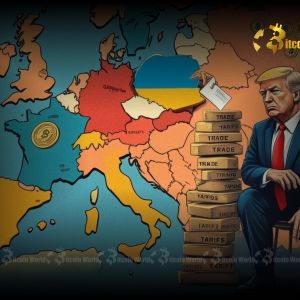Asia FX Rebounds: Navigating Tariff Turmoil and RBA’s Crucial Decision
10 min read
BitcoinWorld Asia FX Rebounds: Navigating Tariff Turmoil and RBA’s Crucial Decision For those accustomed to the exhilarating highs and precipitous lows of the cryptocurrency market, the recent upheaval in traditional financial sectors, particularly within Asia FX , might feel like a familiar narrative. Just as Bitcoin and Ethereum navigate their own unique volatilities, conventional currency markets are constantly buffeted by macroeconomic forces, geopolitical shifts, and central bank pronouncements. The past few weeks have offered a compelling case study in this dynamic, as renewed trade tensions sparked sharp losses across Asian currencies, only for them to show a surprising tick upwards. Now, with the critical Reserve Bank of Australia (RBA) decision looming, investors are holding their breath, pondering what lies ahead for regional currencies and the broader global economic outlook . Understanding the Initial Shock: The Resurgence of Trump Tariffs and Their Ripple Effect The financial world was abruptly reminded of the potent impact of trade policy when news of renewed Trump tariffs broke. This wasn’t merely a political statement; it was a concrete economic measure that immediately threatened to disrupt established global supply chains and trade flows. The announcement, detailing new import duties on a range of goods, triggered an immediate and visceral reaction across financial markets, with Asian currencies bearing the brunt of the initial selling pressure. The rationale behind the sharp losses was clear: increased tariffs translate into higher costs for importers, reduced competitiveness for exporters, and ultimately, a potential slowdown in economic activity. Countries with significant trade exposure to the United States, or those deeply integrated into complex manufacturing supply chains, found their currencies particularly vulnerable. For instance, the Chinese Yuan (CNY) faced immediate depreciation pressures, as did the Korean Won (KRW) and the Singapore Dollar (SGD), given their reliance on global trade and manufacturing exports. Key immediate impacts included: Sudden Capital Outflows: Investors, anticipating reduced corporate earnings and economic deceleration, quickly shifted capital out of riskier emerging market assets and into perceived safe havens like the US Dollar and Japanese Yen. Increased Volatility: Trading desks reported heightened volatility across major Asian currency pairs, reflecting the uncertainty and rapid repositioning by institutional investors. Business Uncertainty: Companies operating across borders began to reassess their supply chains and investment plans, creating a climate of caution that further dampened economic sentiment. This initial shock served as a stark reminder of how quickly political rhetoric can translate into tangible financial market movements, illustrating the delicate balance that underpins the global trade system. The Path to Recovery: Why Asia FX Showed Surprising Resilience Despite the immediate and severe reaction, Asia FX demonstrated remarkable resilience, managing to tick up after the initial sharp losses. This recovery was not a sign that the trade tensions had disappeared, but rather an indication of several underlying factors contributing to a more nuanced market response. The bounce back reflected a combination of technical corrections, evolving investor sentiment, and the inherent strengths of some regional economies. Several elements contributed to this surprising rebound: Technical Rebound and Short Covering: After steep declines, currencies often become “oversold” on technical indicators. This can trigger a technical rebound as traders who had bet against these currencies “cover” their short positions, buying back the currency to close their trades, which pushes prices higher. Market Adjustment to Reality: While the initial reaction to Trump tariffs was severe, markets often overreact. As investors had more time to digest the news and assess the actual scope and potential duration of the tariffs, a more measured perspective emerged. There’s often a realization that the worst-case scenarios might not materialize immediately, or that governments might engage in negotiations. Expectations of Policy Responses: Speculation about potential counter-measures or accommodative monetary policies from Asian central banks also played a role. Faced with economic headwinds, central banks in the region might be inclined to ease monetary policy, provide liquidity, or intervene in currency markets to stabilize their currencies, which can sometimes provide a floor for exchange rates. Strong Economic Fundamentals: Many Asian economies, particularly larger ones like China, boast robust underlying economic fundamentals, including substantial foreign exchange reserves, diversified industrial bases, and strong domestic consumption. These factors provide a significant buffer against external shocks and contribute to investor confidence in the long term. Regional Trade Dynamics: While global trade faced headwinds, intra-Asian trade remains robust, offering some insulation. The ongoing development of regional trade agreements also provides a degree of stability that helps to underpin the value of Asian currencies. This uptick suggested that while trade tensions remain a significant concern, markets are also looking for signs of resilience and potential counter-measures, both from policymakers and the inherent strength of the regional economies. It highlighted the market’s ability to adapt and find new equilibrium points even amidst significant uncertainty. Anticipating the RBA Decision : What’s at Stake for the Australian Dollar and Beyond? As the immediate impact of trade tariffs began to settle, attention quickly shifted to the Reserve Bank of Australia (RBA), whose upcoming decision was poised to be a major market mover. The RBA’s stance on monetary policy is not only critical for the Australian Dollar (AUD) but also holds significant implications for broader currency markets , given Australia’s deep economic ties with Asia and its status as a major commodity exporter. The RBA has been under considerable pressure to stimulate a slowing domestic economy amidst global headwinds. Key factors influencing their decision typically include inflation targets, employment figures, and global economic conditions. Investors are keenly watching whether the bank will opt for a rate cut to boost growth, maintain its current stance while signaling future policy intentions, or, less likely, adopt a more hawkish tone. Potential RBA Outcomes and Their Ripples Across Currency Markets : RBA Decision Scenario Likely AUD Reaction Broader Market Impact (Especially Asia FX) Rate Cut (e.g., 25 basis points) Significant AUD weakness. Lower interest rates make the Australian Dollar less attractive to international investors seeking higher yields, leading to capital outflows and depreciation. Could reinforce expectations of a global easing cycle, potentially weighing on other commodity-linked currencies (e.g., NZD, CAD) and potentially offering some relief to risk assets if seen as growth supportive. May put pressure on other Asian central banks to follow suit. Hold (Dovish Tone) AUD might see initial stability but could weaken gradually if the RBA signals that future rate cuts are highly probable, or if it emphasizes downside risks to the economy. Markets might interpret this as a cautious “wait-and-see” approach, maintaining some uncertainty but avoiding immediate panic. Could still support risk assets if it suggests eventual monetary stimulus. Hold (Neutral/Hawkish Tone) AUD strength. If the RBA resists easing despite global pressures, or even hints at a more positive domestic outlook, the AUD could strengthen as it becomes relatively more attractive. Could be seen as a sign of confidence in the Australian economy, potentially providing some support to regional sentiment and other risk-on currencies, though it might diverge from the global easing trend. The RBA’s decision isn’t merely a local event; it’s a bellwether for how central banks in developed economies are responding to the current global economic climate. A dovish RBA could reinforce expectations of further global monetary easing, impacting interest rate differentials and capital flows across various currency markets , including those in Asia. Beyond Tariffs and Rates: Decoding the Broader Economic Outlook While Trump tariffs and the RBA decision rightly captured immediate attention, understanding the broader economic outlook is paramount for any investor navigating today’s complex financial landscape. These events are symptoms of deeper global trends and interconnected challenges that shape everything from trade flows to investment decisions. Key Drivers and Uncertainties Shaping the Global Economic Outlook : Persistent Global Trade Tensions: Beyond the US-China dynamic, protectionist sentiments are simmering in other regions. The uncertainty generated by these tensions deters long-term business investment, disrupts supply chains, and can lead to a slowdown in global trade volumes, impacting export-oriented economies, especially in Asia. Subdued Inflation and Growth: Many major economies are struggling with stubbornly low inflation and decelerating growth rates. This “low-for-longer” environment for interest rates pressures corporate profitability and can limit the effectiveness of traditional monetary policy tools. Central Bank Divergence vs. Coordination: While some central banks are actively easing monetary policy (like the potential RBA cut), others are holding firm, or even contemplating tightening. This divergence can create significant shifts in currency valuations as capital flows seek out higher yields. Conversely, any signs of global central bank coordination (e.g., on liquidity provision) could offer stability. Geopolitical Risks Beyond Trade: The global stage is rife with other geopolitical flashpoints, from regional conflicts to political instability in key economies. Events like Brexit, or tensions in the Middle East, can introduce unexpected shocks, leading to flights to safety and increased market volatility. Technological Disruption and Automation: Rapid advancements in artificial intelligence, automation, and digitalization are transforming industries and labor markets. While offering immense long-term growth potential, they also present short-term challenges related to job displacement, skill gaps, and the need for significant structural adjustments in economies. Debt Levels: Both sovereign and corporate debt levels remain high in many parts of the world, limiting fiscal policy flexibility and increasing vulnerability to interest rate hikes or economic downturns. The interplay of these multifaceted factors creates a dynamic and often unpredictable environment. Investors must remain agile, continuously analyzing new data and adapting their strategies to evolving circumstances rather than relying on static assumptions about the future. The ability to forecast and react to these broader trends is crucial for success in currency markets and beyond. Navigating the Volatility: Actionable Insights for Investors in Currency Markets In a world where Asia FX can swing wildly due to events like Trump tariffs , and major policy announcements like the RBA decision can reshape the landscape, navigating currency markets and the broader economic outlook requires more than just luck. It demands a disciplined, informed, and strategic approach. Here are actionable insights for investors seeking to protect and grow their capital amidst volatility: Embrace Diversification Across Asset Classes and Geographies: Do not concentrate all your investments in a single currency, asset class, or region. Diversifying across different currencies, equities, bonds, commodities, and even alternative assets can help cushion the blow from localized shocks and reduce overall portfolio risk. For example, balancing exposure to trade-sensitive currencies with those of more domestically focused economies can provide stability. Stay Rigorously Informed and Maintain Adaptability: The financial landscape is in constant flux. Make it a priority to stay abreast of macroeconomic data releases, geopolitical developments, central bank communications, and major news events. Be prepared to re-evaluate your portfolio and adjust your positions based on new information, rather than adhering rigidly to a pre-set plan. Flexibility is paramount. Deep Dive into Currency Pair Dynamics: For those actively trading forex, understanding the unique drivers of specific currency pairs is vital. Research factors such as interest rate differentials (the difference in interest rates between two countries), trade balances, current account deficits/surpluses, political stability, and commodity prices (especially for commodity-linked currencies like AUD or CAD). These fundamental factors often dictate long-term currency movements. Prioritize Robust Risk Management Strategies: This cannot be overstated. Always define your risk tolerance before entering any trade or investment. Utilize tools like stop-loss orders to limit potential losses on currency trades. Manage your position sizes carefully, ensuring that no single trade or asset exposes you to disproportionate risk. Avoid excessive leverage, which can amplify both gains and losses. Cultivate a Long-Term Investment Perspective: While short-term market fluctuations can be dramatic and emotionally taxing, a long-term investment horizon often helps to weather these storms. Focus on the fundamental value of your investments and the long-term trends shaping the global economic outlook , rather than reacting impulsively to every market tremor. Patience and conviction in your long-term thesis can be your greatest allies. Consider Hedging Strategies: For businesses or investors with significant foreign currency exposure, employing hedging strategies (e.g., using forward contracts or options) can help mitigate the risk of adverse currency movements. These insights are not exclusive to seasoned traders; they are fundamental principles that can empower any investor to navigate the complexities of today’s global financial markets with greater confidence and strategic foresight. Challenges and Opportunities Ahead for Asia FX and Global Markets The road ahead for Asia FX and broader currency markets remains fraught with both significant challenges and compelling opportunities. The persistent threat of trade protectionism, exemplified by the lingering effects of Trump tariffs , continues to cast a long shadow, potentially stifling global trade and investment. Geopolitical tensions could escalate in various regions, adding layers of unpredictability. Moreover, the effectiveness of monetary policy, even after pivotal decisions like the RBA decision , in stimulating sustainable growth is increasingly being debated, raising questions about the limits of central bank intervention. However, amidst these challenges, opportunities abound for discerning investors. The inherent resilience and dynamism of many Asian economies, driven by growing domestic consumption and technological innovation, present attractive long-term prospects. Shifts in global supply chains, while disruptive, could also create new winners and losers, offering investment opportunities in companies or regions that adapt successfully. Furthermore, the potential for coordinated global policy responses to economic slowdowns, or the emergence of new trade blocs, could provide unexpected tailwinds. The global economic outlook demands a cautious yet opportunistic mindset. The ability to meticulously analyze data, distinguish between transient market noise and genuine signals, and adapt strategies quickly will be paramount for capitalizing on the opportunities while mitigating the risks. Summary: Navigating the Tides of Global Finance with Foresight The recent dramatic shifts in Asia FX , initially sparked by renewed Trump tariffs and subsequently influenced by critical central bank actions like the RBA decision , serve as a powerful reminder of the inherent volatility and profound interconnectedness of global finance. While Asian currencies initially experienced sharp losses, their subsequent uptick underscores the market’s remarkable capacity for resilience and adaptation in the face of adversity. The broader economic outlook remains characterized by uncertainty, shaped by persistent trade tensions, evolving monetary policies across central banks, and a myriad of geopolitical shifts. For investors navigating these complex waters, the key to success lies not in predicting every twist and turn, but in adopting a robust and adaptable strategy. This involves staying rigorously informed about global macroeconomic trends, embracing comprehensive diversification across asset classes and geographies, and maintaining an unwavering commitment to disciplined risk management. As the world continues to grapple with these multifaceted challenges, agility, strategic foresight, and a steadfast long-term perspective will prove invaluable in navigating the dynamic tides of currency markets and securing a resilient financial future. To learn more about the latest Forex market trends, explore our article on key developments shaping global currencies liquidity. This post Asia FX Rebounds: Navigating Tariff Turmoil and RBA’s Crucial Decision first appeared on BitcoinWorld and is written by Editorial Team

Source: Bitcoin World



